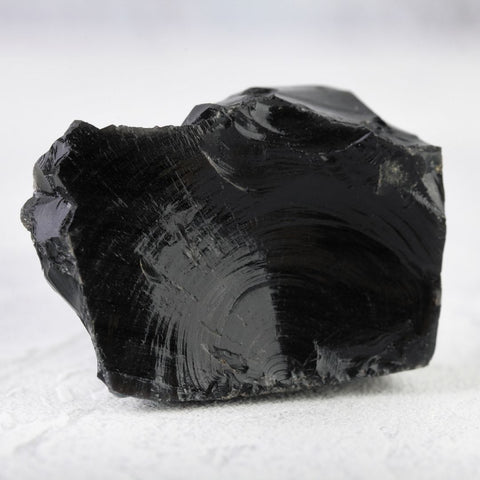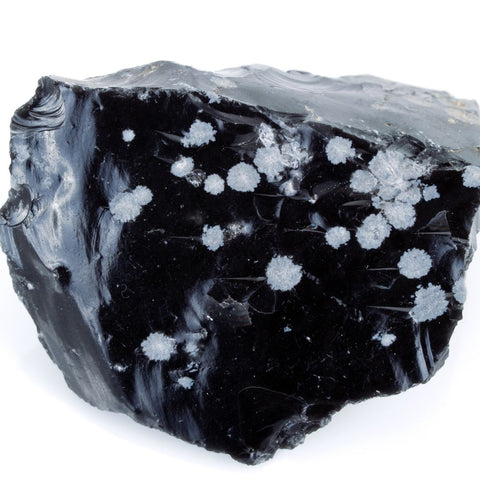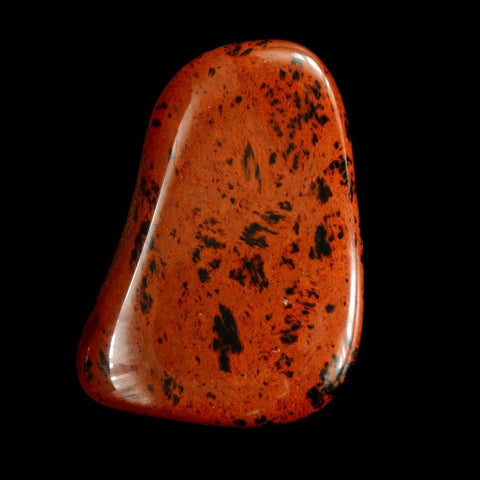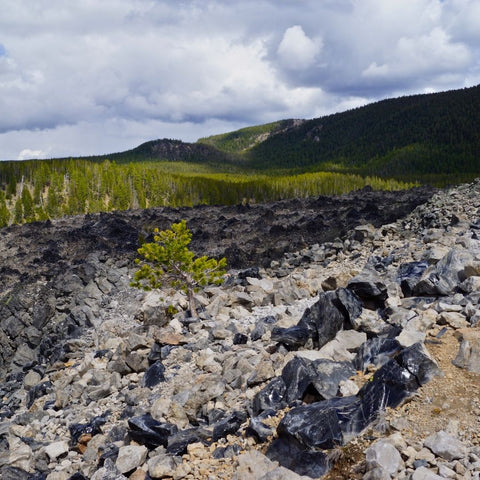For many people, obsidian is a jewelry favourite. This natural glass, formed from volcanic activity, has a look that’s hard to find in any other gem. Obsidian comes in diverse colours, including blue, green, gold, silver, reddish-brown, and rainbow-coloured obsidians. Plus, it’s incredibly versatile and relatively easy to work with, making it a favourite among boutique jewelry makers.
But many people ask, “Is obsidian a gem, or is it something else?” If you’re curious about obsidian, here’s a look at some fun obsidian facts, including whether obsidian is a gem, how it is made, and more.
Obsidian Properties – Is Obsidian a Gem or Volcanic Glass?

If you’re wondering, “Is obsidian a gem, or is obsidian a mineral?” the answer is neither. Technically, obsidian is a kind of naturally occurring volcanic glass, though it’s usually considered an igneous rock. However, it is sometimes classified as a mineraloid, as it does have many mineral-like qualities.
When it comes to what obsidian is made of, silica plays a big role. The silica is part of why obsidian has such a lovely glassy finish that brilliantly reflects the light.
However, it isn’t always the only component. Different inclusions or impurities can alter the final colour of the stone. Still, their presence doesn’t mean you aren’t looking at a piece of obsidian. The clarity of obsidian also contributes significantly to its beauty, enhancing its overall appeal.
How is Obsidian Formed?

Obsidian is formed through a rapid cooling process of high-silica lava, resulting in volcanic glass with minimal crystal growth.
This process begins with volcanic eruptions, during which silica-rich molten rock (magma) is expelled from the Earth's mantle. The high silica content makes the lava highly viscous, and as it flows onto the Earth's surface or comes into contact with water, it cools rapidly.
This swift cooling prevents the formation of crystals, leading to a glassy texture. The atoms in the lava do not have enough time to arrange themselves into a crystalline structure, forming instead a disordered, glass-like structure. The resulting product is obsidian, a natural volcanic glass with a smooth, uniform texture.
Factors such as the cooling rate, the presence of water, and the lava's composition play crucial roles in forming obsidian.
Obsidian's smooth, glassy texture often features conchoidal (shell-like) fracture patterns and forms extremely sharp edges when broken, making it valuable for tools and weapons in ancient cultures.
Obsidian Colours & Varieties
The black obsidian stone commonly comes to mind when people think of obsidian. Black obsidian is usually what you find in jewelry and is also incredibly popular with lapidaries. However, obsidian colours include a wide range, such as black, gold, silver, reddish-brown, rainbow-coloured, blue, and green.
Primary Types of Obsidian: Snowflake Obsidian
Black Obsidian: The most common type, characterized by its dark, glossy surface. It’s often used for making tools and ornaments.
Rainbow Obsidian: Displays iridescent, rainbow-like colours when polished due to nano-scale inclusions or layering.

Snowflake Obsidian: Contains white or grayish inclusions of cristobalite crystals that resemble snowflakes scattered throughout the black glass. Snowflake obsidian is a black stone that features white inclusions. It gives the piece a mottled appearance, not unlike snowflakes scattered across the night sky.

Mahogany Obsidian features reddish-brown and dark brown stripes or patches, giving it a mahogany-like appearance. Thanks to the presence of iron, Mahogany obsidian is usually brick-red. It can also feature varying amounts of black, generally in a mottled or striped pattern.
Golden Sheen Obsidian: This mineral exhibits a golden, metallic sheen caused by gas bubbles trapped during its formation. Golden obsidian usually has a darker base colour, like black or deep brown. However, it also has a golden sheen, making it seem like tiny golden glitter particles are trapped beneath the surface.
Silver Sheen Obsidian: Similar to Golden Sheen Obsidian but with a silver, metallic sheen.

Apache Tears: Small, rounded pebbles of obsidian, often found in a more translucent form than typical obsidian.
Green Obsidian: Rare and primarily found in certain areas; its green colour comes from the presence of iron or other minerals.
Blue Obsidian: Another rare type, usually man-made, but natural blue obsidian does exist in very few locations. The exact shade can vary slightly, with some pieces being a stronger sapphire hue while others are closer to a robin’s egg or even a light teal.
Fire Obsidian: This rare variant displays a colourful, flame-like pattern due to light diffraction from thin layers within the stone. It is another rare variant with amazing colours. Instead of a largely black base, fire obsidian tends to be clear with iridescent qualities. It can have a breathtaking play of colour, with hues that mimic the Northern Lights, the flames in a campfire, the light bouncing off of soap bubbles, the shine of oil slicks, and more.
Peacock Obsidian, also known as Velvet Obsidian, is a type of obsidian that exhibits vibrant, multicoloured patterns reminiscent of a peacock’s feathers. The colours typically include shades of green, blue, purple, and sometimes gold, created by the interplay of light on microscopic inclusions or internal layering within the stone. This effect, known as iridescence, gives Peacock Obsidian its unique and striking appearance.
This type of obsidian is prized for its beauty and is often used in jewelry and decorative pieces. Metaphysically, Peacock Obsidian is believed to have properties similar to other types of obsidian, such as grounding and protection. Still, it is also thought to bring joy, creativity, and a sense of wonder to those who use or wear it.
The History of Obsidian
Obsidian has a long history, serving as a widely-used stone in many cultures. What is obsidian used for today? Ornamental purposes are the norm. However, while many people think of obsidian as a gem for jewelry, back in the stone age, that wasn’t the case.
One of the original uses for obsidian was weaponry and cutting tools. Since it’s glass, the edge can get incredibly sharp, making the stone a logical choice for knives, spear tips, arrowheads, and similar purposes. The sharp edges made obsidian exceptionally valuable to ancient people for crafting tools and weapons.

However, even in an era when we have access to metals and other materials, we still use obsidian as a cutting tool. In fact, obsidian blades are sometimes used in surgeries, largely because the cutting edge can be sharper with obsidian than what you can get in a traditional steel scalpel.
Religious and Cultural Significance of Obsidian
Obsidian glass holds significant cultural and historical importance across various regions and cultures worldwide. Here are some notable examples:
Mesoamerica
-
Aztecs and Mayans:
-
Tools and Weapons: Obsidian was highly valued for making sharp-edged tools and weapons, such as knives and arrowheads.
-
Rituals: Used in religious rituals and ceremonies. The Aztecs, for example, crafted mirrors and scrying stones from obsidian for divination and communication with deities.
-
Symbolism: Associated with the god Tezcatlipoca, whose name means "Smoking Mirror," reflecting the use of obsidian mirrors in spiritual practices.
-
North America
-
Native American Tribes:
-
Tools and Artifacts: Various tribes used obsidian for making tools, arrowheads, and ceremonial items.
-
Trade: Obsidian was valuable among different tribes due to its utility and rarity in certain regions.
-
Spiritual Significance: Considered a protective stone, used in various spiritual and healing practices.
-
Near East
-
Ancient Civilizations:
-
Catalhöyük: One of the earliest known Neolithic settlements, Catalhöyük in modern-day Turkey, has yielded obsidian artifacts dating back to 7500 BCE. These were used for tools, mirrors, and jewelry.
-
Trade: Obsidian was traded extensively in the ancient Near East, indicating its value and importance in early commerce.
-
Europe
-
Ancient Greece and Rome:
-
Artifacts: Used to make tools, weapons, and decorative items.
-
Mythology: In Roman mythology, obsidian was linked to Pluto, the god of the underworld, and was thought to have protective and mystical properties.
-
Other Regions
-
Easter Island:
-
Moai Statues: Obsidian was used to carve the eyes of the iconic Moai statues, giving them a distinctive and powerful appearance.
-
Tools and Weapons: Also used for crafting tools and weapons by the Rapa Nui people.
-
-
Japan:
-
Jomon Period: Obsidian was used to make tools and ceremonial objects during the Jomon period, reflecting its significance in early Japanese culture.
-
Modern Significance
-
New Age and Metaphysical Communities:
-
Healing and Protection: Widely used in modern spiritual practices for its purported healing and protective properties.
-
Jewelry and Decoration: Continues to be a popular material for jewelry and decorative items, valued for its beauty and metaphysical qualities.
-
Obsidian's unique properties and historical uses underscore its enduring significance across different cultures and regions throughout history.
Where Is Obsidian Found?

How obsidian is formed relies on volcanic activity. So you'll only find it in areas that either currently or previously had active volcanoes. While this might make it seem like obsidian would be relatively rare, that isn't necessarily the case. Many parts of the planet have been home to volcanic activity, so obsidian is widespread.
Large obsidian deposits exist in numerous countries, including Argentina, Canada, Ecuador, Iceland, Indonesia, Kenya, New Zealand, Russia, the United States, and more. However, the majority of obsidian jewelry is produced in the United States.
Obsidian Jewelry

Obsidian jewelry is incredibly popular and highly accessible. Its popularity in jewelry is largely due to its striking colour and clarity. In most cases, obsidian is either turned into beads or cabochons. However, some lapidaries do turn it isn’t faceted gems, particularly more transparent stone versions. Additionally, you may find shaped pieces, such as an arrowhead pendant created out of obsidian.
If you’re looking for obsidian necklaces, you might find strands of beads or pendants. With a black obsidian bracelet, beads are the most common option. However, you may also find a series of set cabochons too.
Shop Our Obsidian Jewelry Collection
Typically, obsidian is set in silver. But that also doesn’t mean you can’t find gold jewelry with obsidian. Usually, the only metal you won’t find obsidian paired with is platinum, mainly because that metal tends to be significantly more expensive than the others. That doesn’t align with a lower-cost stone like obsidian.
Obsidian Meaning and Metaphysical Properties

The meaning of obsidian can vary from one belief system to the next. The piece’s colour can also play a role, particularly when associating a sample with a chakra.
Obsidian, a type of volcanic rock, is renowned in the metaphysical community for its powerful properties. Here are some of the key metaphysical properties associated with various kinds of obsidian:
Obsidian Metaphysical Properties
-
Protection: Obsidian is a protective stone, shielding against negativity, psychic attacks, and harmful energies.
-
Grounding: It has strong grounding qualities, helping to anchor one's energy to the Earth and promoting stability.
-
Clarity and Truth: Obsidian can bring hidden truths to light, aiding in self-reflection, personal growth, and healing.
-
Emotional Healing: It is believed to help release emotional blockages and traumas, promoting emotional well-being.

🌟 Need a little push forward? The Fierce Momentum Bracelet blends the uplifting energy of Citrine and Kyanite with the steady grounding of Obsidian and Sodalite. This bracelet is designed to inspire positive flow and keep your energy moving forward throughout the day. Colours vary naturally, making each piece unique.
Metaphysical Properties of Specific Types of Obsidian
-
Black Obsidian:
-
Shielding: Acts as a strong protective barrier against negativity.
-
Purification: Helps to cleanse and purify the aura.
-
Psychic Abilities: Enhances intuition and psychic abilities.
-
-
Rainbow Obsidian:
-
Joy and Optimism: Brings light and joy into one's life.
-
Emotional Healing: Assists in healing emotional wounds and past traumas.
-
Balancing Energy: Balances and aligns the chakras.
-
-
Snowflake Obsidian:
-
Calming: Provides a soothing and calming effect.
-
Balance: Helps maintain balance and focus in life.
-
Acceptance: Encourages acceptance of change and transformation.
-
-
Mahogany Obsidian:
-
Strength: Enhances strength and personal power.
-
Grounding: Strongly grounding, connecting to the Earth.
-
Protection: Shields against negativity and energy drains.
-
-
Golden Sheen Obsidian:
-
Manifestation: Aids in manifesting desires and goals.
-
Personal Power: Enhances confidence and personal power.
-
Insight: Provides insight and clarity in difficult situations.
-
-
Silver Sheen Obsidian:
-
Reflection: Encourages reflection and inner growth.
-
Protection: Offers protective energy and enhances meditation.
-
Clarity: Improves clarity of mind and spiritual awareness.
-
-
Apache Tears:
-
Grief: Helps in overcoming grief and sorrow.
-
Healing: Provides emotional healing and comfort.
-
Grounding: Grounding and protective qualities.
-
-
Green Obsidian:
-
Healing: Promotes physical and emotional healing.
-
Abundance: Attracts abundance and prosperity.
-
Heart Chakra: Opens and balances the heart chakra.
-
-
Blue Obsidian:
-
Communication: Enhances communication skills and clarity.
-
Spiritual Growth: Aids in spiritual growth and insight.
-
Psychic Abilities: Strengthens psychic abilities and intuition.
-
-
Fire Obsidian:
-
Transformation: Encourages transformation and growth.
-
Energy: Boosts energy levels and vitality.
-
Creativity: Enhances creativity and passion.
-
Obsidian's powerful and diverse metaphysical properties make it a versatile and highly valued stone in spiritual practices and healing.
Essentially, every version is going to have a slightly different meaning. However, it's critical to remember that gemstones shouldn't be considered substitutes for medical care in any of those cases. Holding, wearing, or meditating on a stone may boost your mood or mindset. Still, it isn't a proven way to treat any health condition, so it shouldn't be used in place of visiting your doctor.

Stones Similar to Obsidian
Many stones can be similar to obsidian, depending on the colour you're trying to substitute. For black obsidian, black onyx and black spinel may be fairly close matches. Black tourmaline or black jasper could be other reasonable substitutes.
For golden obsidian, black cat's eye scapolite could work, though the gold colouring tends to be weaker in the cat's eye stone. Black star sapphire may be a better match, but it may not be as easy to find.
At times, black rutilated quartz may be a decent stand-in for snowflake obsidian and certain pieces of marble or onyx. For blue obsidian, topaz, Aquamarine, tourmaline, spinel, and many other gems with blue variants could work. Other stones could also substitute for different colors of obsidian









